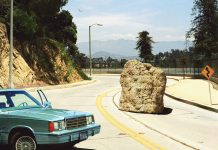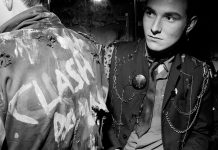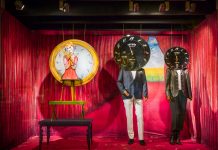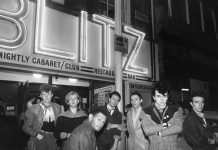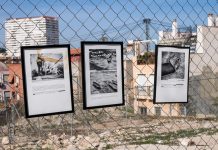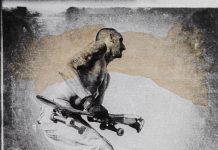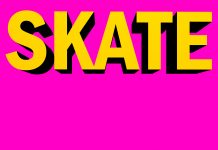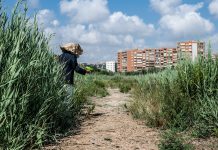
City Skate Tour #5 Alicante, 18 April 2021. Calle Sant Agustí. Casco Antiguo – Santa Cruz. Alicante. Spain.
(1) City Skate Tour starts from a performative idea of urban space through a dissident sample of photographs, texts, photocopied, altered images, all of them belonging to the City 00Skate Days (CSKD) series. (2) To the extent that skateboarding seeks a new vital and social rhythm in the appropriation of the city and the search for alternative itineraries, the photographic exhibition can also become a differentiated urban practice, capable of creating visual thresholds far removed from uses and institutional submissions of art.
(3) The city is the nexus between image and skate. There is no claim in this. There is no other result than that which a passerby could attribute to you when encountering an unexpected image, an attribution of which any value or meaning is unknown. (4) But there are other ways of saying it: City Skate Tour proposes intervention in peripheral enclaves and restores the rhythm of a random, minimal world. That is why the influx of people in those specific spaces do not matter so much as the way in which the image becomes visible through the context that surrounds it. Skateboarding is a metaphor for that threshold.
(5) In City Skate Tour, the idea is projected into a basic action: crossing the city can be considered an imperceptible, inconsequential happening, but if at some point in the journey something causes the passer-by to stop, the action could also become a social fact. In this case, stopping is accompanied by other minimal acts: assembling the images to an urban surface has more to do with creating a site for the image than with a purely expository need.
(6) Between the action and the fact there is a whole compendium of social and artistic traditions that were going to try to show the city as something tangible associated with an altered, even revolutionary dynamic. The references are multiple, but what interested me is, above all, that the city can be used to express ideas, whether complex or simple. Ideas that become tangible in action. (7) The public expression of a work requires some type of social requirement, and this does not have to be restricted to the programmatic conventions of galleries or institutions.
(8) If the Situationists had shown another way of conceptualizing the urban experience based on a playful-constructive behavior, radicalized by their insistence on requesting for themselves a vital state that denied capitalist norms, I find in the gesture of the painter Peter Hobbs a current that unites art, nomadism and situationism. The art critic Thomas Crow would express it as an emerging art form that moved away from any foreseeable gaze: «Peter Hobbs led the situationist aesthetic towards a process of isolated nomadism», and he did so by hosting his canvases on vacant lots in the East End of London to photograph them later as an indirect, but more vivid and real, way of recreating the painting in an urban installation. War photographer Don McCullin helped him create that sensation through photographs that were to fix the fact, that moment, on the margins of institutional life.



Fotocopia #7. Indio. 2015-2018. Texto. For many skaters themselves, skateboarding is much more than merely a leisure pastime. It can justifiably be seen as a form of youth culture, in the sense that it has its own preferred modes of symbolic representation, its own aesthetic, its own ethical codes and rules and its own ideology. To be a skateboarder is to be more than just a person who happens to roll about the city streets on a piece of wood. Being an accomplished skater, and knowing where and how to skate, is obviously part of the story; as is wearing particular clothes and accessories, having a particular hairstyle, listening to particular kinds of music, and choosing particular products or brands. But the skilful use of these external markers also helps to define you as a member of a group that is presumed to share particular values, values that are to some degree defined in opposition to, or at least as an alternative to, those of mainstream adult society. Becoming a skater entails a process of self-identification: it is about the assertion of an attitude, and the claiming of an identity, that is literally embodied in particular forms of visual appearance and physical style. Referencia. David Buckingham. Skate perception: self-representation, identity and visual style in a youth subculture, 2009.
Fotocopia #44. Beat. 2019-2021. Texto. The implications of social resistance are based on the assumption that human behavior is not determined solely by a dominant ideology or economic relations, but rather that humans are able to respond creatively to their social and economic conditions through various daily and cultural practices. The implication is that humans can challenge dominant practices, create alternative practices, and potentially create social change through cultural practices. Even though the social impact of skateboarding is not transformative for most people, the significance lies in the fact that these participants were empowered to act in their best interests. They created and experienced alternative types of relations that met their needs. The ability of skaters to use a physical activity in this manner suggests that other activities can be created to reclaim power. The knowledge of creating alternatives can serve as a blueprint for future interaction or social actions and cultural products, and it can also inspire and give credence to the idea that there are social choices and that groups of people have the ability to create alternatives. Referencia. Becky Beal. Disqualifying the official: An exploration of social resistance through the subculture of skateboarding, Sociology of Sport Journal, 1995.




